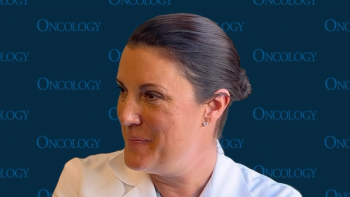
Oncology NEWS International
- Oncology NEWS International Vol 4 No 8
- Volume 4
- Issue 8
Coalition Promotes Worksite Cancer Screening
CONCORD, NH--Pharmaceutical companies were the pioneers in establishing cancer screening and information programs for their employees. This is why Jack Gentile went first to the pharmaceutical industry for help in founding the Industries' Coalition Against Cancer, an organization dedicated to encouraging corporations to initiate their own cancer screen/prevention programs or to enhance existing programs.
CONCORD, NH--Pharmaceutical companies were the pioneers in establishingcancer screening and information programs for their employees.This is why Jack Gentile went first to the pharmaceutical industryfor help in founding the Industries' Coalition Against Cancer,an organization dedicated to encouraging corporations to initiatetheir own cancer screen/prevention programs or to enhance existingprograms.
Coalition members share information about their worksite cancerscreening experiences, including cost-effectiveness calculations,through publications and an annual conference.
Speaking at a New Hampshire Employee Health Forum, sponsored bythe state's Division of Public Health Services, Mr. Gentile, chairmanof the Coalition, said that it has now grown to include more than100 companies, cancer organizations, and cancer centers.
The Coalition stresses that cancer prevention and, in most cases,early detection will save lives, said Mr. Gentile, president ofPRR, Inc. (publisher of Oncology News International, the journalONCOLOGY, and Primary Care & Cancer).
The worksite is a logical place for screening and informationprograms, since more than 50% of the total population is in theworkplace. This figure climbs to more than 90% when retirees,spouses, and dependents are included. Since women make up morethan 55% of the total workforce, worksite screening presents aperfect opportunity to reach a major segment of the female population,Mr. Gentile said.
He cited two companies that have seen a cost savings with worksitemammography screening. Coors Brewing, for example, spends $78,000a year on its mammography screening program. To date, after 13,333screens, 51 cancers have been detected, only four of which werelate stage disease.
For early detection, the company calculated a treatment cost,including disability, of $28,165, compared with $193,108 for latestage disease. Using these figures, the overall savings has beencalculated at over $800,000 a year.
Zeneca Pharmaceuticals' breast screening program has detectedeight cancers, four at stage I, three at stage II, and one atstage III. Six of the eight women were under age 50 when the cancerwas discovered. "The best news of all," Mr. Gentilesaid, "is that all eight women are alive, active, and doingwell. Six still work at Zeneca, and two have retired."
Using the Coors program calculations for the cost difference betweenearly and late stage diagnosis and treatment, the entire programwas paid for by the first women diagnosed with stage I breastcancer, he said.
Two years ago, Zeneca also initiated a prostate cancer screeningprogram. Of 243 PSA tests given in 1994, 43 were referred forfollow-up. Only one required a biopsy, which showed malignancy."The tumor was confined to the gland and was treatable,"Mr. Gentile said. Again, detection of this one early-stage cancerled to an estimated $47,000 savings.
Articles in this issue
over 30 years ago
CA 125 Predicts Response to Chemo in Ovarian Caover 30 years ago
Biochemical Modulation Promising in RT-Resistant GI Cancerover 30 years ago
Cancer Institute of NJ Adds to its Staffover 30 years ago
A Century of Breast Cancer Litigation Is 'Deconstructed'over 30 years ago
New Depot Formulation of LHRH Analogue Allows 12-Week Dosingover 30 years ago
NSABP Investigation Threatens Academic Freedom for All: Fisherover 30 years ago
Cancer Fax Directory in 3rd Editionover 30 years ago
HIV-Related Malignancies Increasing, Physicians Tell Panelover 30 years ago
Breast Cancer Risk Factors Remain Elusive TargetNewsletter
Stay up to date on recent advances in the multidisciplinary approach to cancer.


















































































